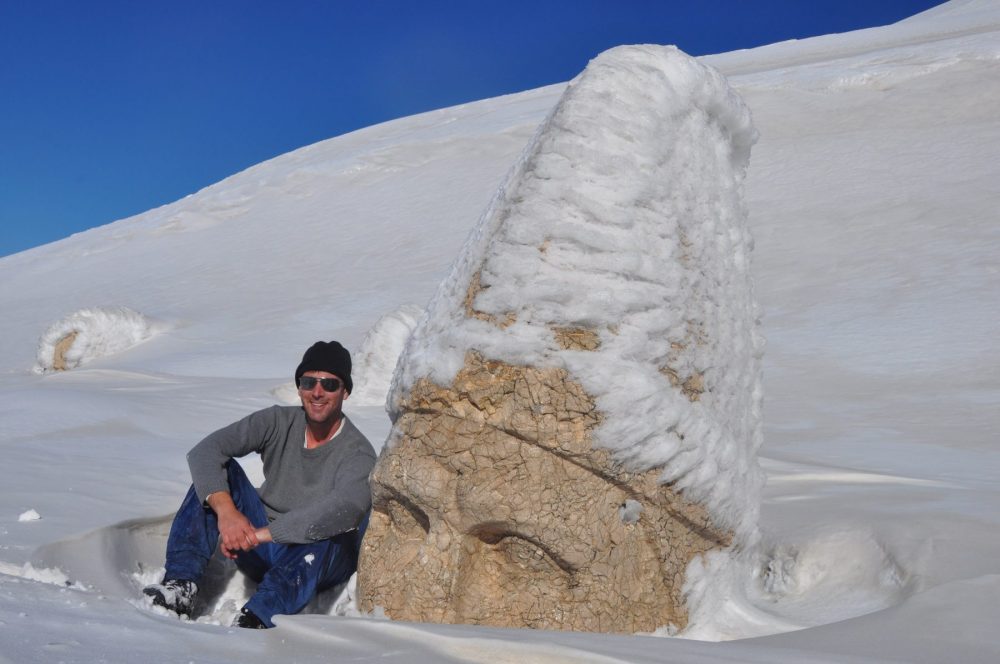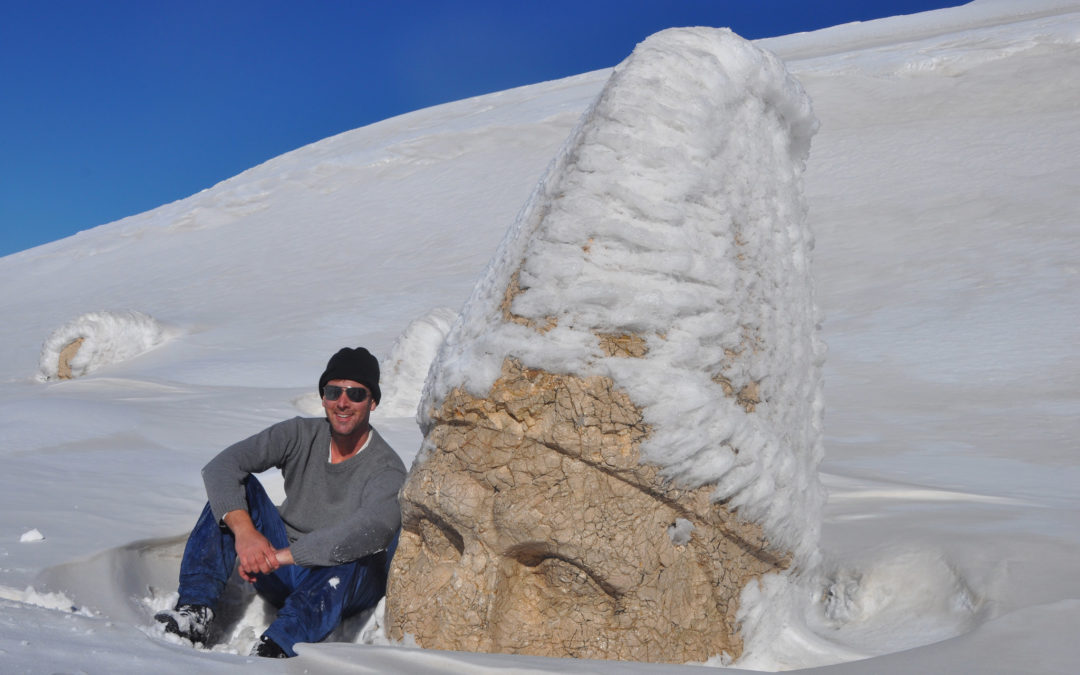December 2013: I visited central Turkey with the sole purpose of climbing Mount Nemrut in winter. Mount Nemrut is one of Turkey’s most famous archaeological sites and visited by tour buses but in winter it is blocked by heavy snow and abandoned. I knew that if I could travel to one of the nearby villages, I could get a walking map and climb to the top having all of Mount Nemrut and its ancient statues all to myself. This was the goal I set off to achieve.
About Mount Nemrut
Mount Nemrut is a 7000′ tall mountain that Greek king Antiochus made famous for building a religious sanctuary dedicated to himself in 62 B.C.. Antiochus built a cult for himself and wanted to be worshipped after his death. Antiochus directed that his tomb be built in a high and holy place, remote from people and close to the gods, where his body could be preserved for eternity. An artificial mountain top was built as his tomb and giant sandstone statues of himself, eagles, lions and Greek Gods Antiochus were erected around his tomb.

Location of Mount Nemrut
I traveled all day to get to Nemrut from Erbil Iraq via public transportation. On the Turkish side the bus driver had to drop me off at night on the side of one of the major roads and from there I either had to hitchhike or hire a taxi to get to the small village of Kahta, the closest village to Nemrut where I would be spending the night. I definitely had my doubts that I would get to Kahta in one day especially when I was standing on the side of the road in the freezing cold, and no one was stopping. I walked to the outskirts of a town so at least it would be easier to find a taxi and my bet paid off and after a 1/2 of waiting a lone taxi drove by and I frantically waved prompting the txi to pull over. I was in luck and the taxi agreed to take me to Kahta and the price was affordable and a few hours later I showed up at a family run guesthouse around 11pm. I had already sent a message that I would be arriving late so the guest house owner was expecting me. I made it and now I would be able to walk to the top of Nemrut the next morning.

Top of Nemrut
The next morning, I spoke the man that owned the guesthouse and asked him directions to the top of Nemrut. The road was closed as I expected and covered in deep snow. He pointed to Nemrut and explained that my biggest obstacle would be the deep snow and that it would take me a few hours to climb to the top. From the guesthouse I brought all my cold weather gear, some food and water and started hiking. I was fortunate to cross paths with a local villager with a rifle slung over his shoulder who was heading into the mountains to hunt. When I told him where I was going, he said he was going the same direction almost until the top of the peak and that I could follow him. This worked out great and probably saved me from getting lost. There were no villages or other people on the mountain and no other tracks in the fresh snow other than some wolf prints leading up to the top of the mountain. The man explained that wolves are common in the mountains. As promised the man led me to a place where I could easily see the peak and continue hiking on my own. From there we parted ways and I continued to hike alone in deep snow up to my waist in parts. At the top I found what I came for the giant sandstone statues King Antiochus jutting out from the snow facing outwards just as they have been for thousands of years. I stood beside them along on the mountain in total awe of the ancient carvings. There were more statues, but the massive snow drifts covered them revealing only small sections of sandstone.

View from Nemrut

King Antiochus Statue

King Antiochus Statue

King Antiochus Statue

I set my camera up on self timer to take this selfie next to the King Antiochus Statue
Getting back to the guesthouse was easy because I just followed my tracks in the snow and once I returned sometime in the afternoon I hired a taxi to take me to the nearest sizable town where I then caught a shared taxi for the long drive to the Kurdish city of Diyarbakir, which is a sensitive area to the Turkish government because of the fighting with Kurdish separatists that are fighting an insurgency from places like Diyarbakir.

Friendly Kurdish kids at a kebob ship i ate at in Diyarbakır
I spent a night in Diyarbakir, which was heavily militarized with Turkish soldiers and the people were completely un-accustomed to seeing foreigners in the city and I attracted a lot of attention, but it was all friendly and people were very kind. I stayed in a guesthouse before flying the next day to Istanbul.

